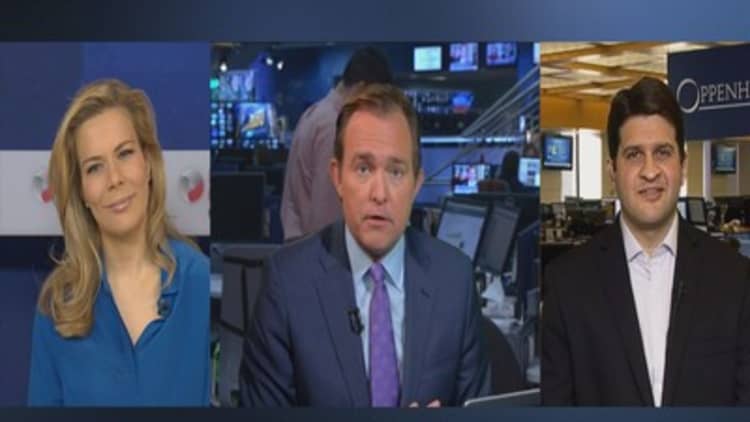
After years of safely reaching for yield through risky assets like stocks and speculative-grade bonds, Wall Street is heading into 2016 rethinking the strategy.
Most market pros who have weighed in with year-ahead forecasts so far see equities posting anywhere from a flat year to modest gains. There is, however, sharper disagreement over high-yield bonds, which often are seen as an effective proxy for stock market behavior.
Fixed income experts worry that the appetite for risk in a low-rate environment is about to become more dangerous. As a result, they're telling clients to adjust their behavior.
"How do we get our investors to unreach for yield?" Darrell Cronk, president of the Wells Fargo Investment Institute and the firm's chief investment officer of wealth and investment management, said at a media briefing earlier this week.
Read MoreBond market is starting to get cold feet about rates
Cronk said investors have been lured by a huge level of high-yield, or junk, issuance over the past five years — more than $1.7 trillion — that has come with low default rates and much better yields than in government bonds.
"We think that is very normal," he said. "But we think investors have gotten over their skis a little bit."
Indeed, the footing has gotten a little rough lately in the high-yield space.
That trend of low defaults has begun to turn the other way, with the trailing 12-month rate rising to 2.8 percent in November, the highest level in three years, according to ratings agency S&P, which expects defaults to climb to 3.3 percent by Sept. 30, 2016.
Moreover, fellow ratings agency Moody's reported its liquidity stress index in November hit its highest rate since February 2010. Still more troubling is that some of the damage has begun to spill outside the oil, gas and mining sectors, where most of the defaults had been contained.
Fully one-third of oil and gas and mining and metals companies in Moody's coverage universe are on review for downgrade or have negative outlooks.
Read MoreThe junk bond market 'keeps me up at night': Trader
"This is indicative of the bleak outlook for 2016," Moody's said in a report. "We expect this downturn to be longer lasting than average and project a further spike in commodity-related defaults over the next 12 months."
Still, not everyone is as pessimistic. Many strategists believe it will be a matter of selectivity for investors looking for higher levels of income in the spec-grade space.
"We don't think companies are over-levered," Michael Lillard, chief investment officer of Prudential Fixed Income, said at a separate media briefing, also this week. "They haven't done huge amounts of capex, they haven't hired a lot of workers. We don't see a precursor for a wave of defaults."
The S&P U.S. Issued High Yield Corporate Bond Index is off 1.5 percent year to date, underperforming the large-cap stock index, which had gained about 0.7 percent in 2015 through midday trading Friday.
Lillard believes there are solid opportunities in some sectors, specifically utilities and casinos — "good, defensive credits," as he put it.
There are warning signs, however.
In addition to the rise in defaults and the liquidity issue, which Lillard conceded has reached a post-recession low, spreads between junk yields and government debt have widened significantly. While spreads between investment-grade bonds and Treasurys have narrowed a bit, junk spreads in November surged to 713 basis points (7.13 percentage points) from 664 basis points in October, according to S&P.
Widening spreads are often seen as signals for a recession, something that could decimate high yield. Wells Fargo's experts, though, said spreads historically can reach 800 to 1,000 basis points before a recession hits.
"If that's the case, these spread levels at some point become attractive," said Brian Rehling, co-head of global fixed income strategy at Wells Fargo. "The problem is, I don't think we're at the bottom yet."
Then there's the Federal Reserve. The U.S. central bank is expected to go ahead with its first rate increase in nine years at the Federal Open Market Committee meeting Dec. 15-16. Rising rates could spell further problems for fixed income in that yields and prices move in opposite directions, so bondholders could see substantial capital losses should rates move up quickly.
The base case for Wells is a quarter-point hike in December, then two more in 2016, likely in early summer and December so as not to have political ramifications in the presidential race.
In the meantime, companies are trying to get under the wire for Fed tightening, just in case appetite wanes dramatically.
High-yield issuance jumped in November, with the $22.9 billion level the highest since May, according to the Securities Industry and Financial Markets Association. Overall, junk debt brought to market has declined 15 percent from its 2014 level to $255.9 billion year to date. That's counter to trends in investment-grade issuance, which has grown 10 percent.
Investors of late have been buying into the junk space, with the $1.2 billion in inflows last week to high-yield bond funds the first positive move in four weeks, according to Bank of America Merrill Lynch.
The popular SPDR Barclays High Yield Bond exchange-traded fund has taken in $492.6 million since Nov. 26, the third highest of any ETF, according to FactSet and ETF.com.






